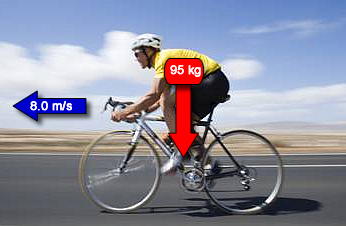A Level Specific Heat Capacity Questions
Q7. A bicycle and its rider have a total mass of 95 kg. The bicycle is travelling along a horizontal road at a constant speed of 8.0ms-1.

(a) Calculate the kinetic energy of the bicycle and rider.
Ek = ½mv2
Ek = ½ x 95 x 8.02 
Ek = 3040 J 
(2 marks)
(b) The brakes are applied until the bicycle and rider come to rest. During braking, 60% of the kinetic energy of the bicycle and rider is converted to thermal energy in the brake blocks. The brake blocks have a total mass of 0.12 kg and the material from which they are made has a specific heat capacity of 1200 J kg-1 K-1.
(i) Calculate the maximum rise in temperature of the brake blocks.
60% of the KE = 0.60 x 3040 = 1824 (J) 
ΔQ = mcΔθ
1824 = 0.12 x 1200 x Δθ
Δθ = 13 K 
(ii) State an assumption you have made in part (b)(i).
No heat is lost to the surroundings 
(4 marks)
(Total 6 marks)







